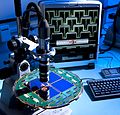Plik:PIA17993-DetectorsForInfantUniverseStudies-20140317.jpg

Rozmiar podglądu – 624 × 600 pikseli. Inne rozdzielczości: 250 × 240 pikseli | 499 × 480 pikseli | 799 × 768 pikseli | 1065 × 1024 pikseli | 2130 × 2048 pikseli | 3000 × 2884 pikseli.
Rozmiar pierwotny (3000 × 2884 pikseli, rozmiar pliku: 842 KB, typ MIME: image/jpeg)
Historia pliku
Kliknij na datę/czas, aby zobaczyć, jak plik wyglądał w tym czasie.
| Data i czas | Miniatura | Wymiary | Użytkownik | Opis | |
|---|---|---|---|---|---|
| aktualny | 23:13, 17 mar 2014 |  | 3000 × 2884 (842 KB) | Drbogdan | User created page with UploadWizard |
Lokalne wykorzystanie pliku
Poniższa strona korzysta z tego pliku:
Globalne wykorzystanie pliku
Ten plik jest wykorzystywany także w innych projektach wiki:
- Wykorzystanie na an.wikipedia.org
- Wykorzystanie na ar.wikipedia.org
- Wykorzystanie na az.wikipedia.org
- Wykorzystanie na de.wikipedia.org
- Wykorzystanie na en.wikipedia.org
- Wykorzystanie na fa.wikipedia.org
- Wykorzystanie na fr.wikipedia.org
- Wykorzystanie na gl.wikipedia.org
- Wykorzystanie na he.wikipedia.org
- Wykorzystanie na hy.wikipedia.org
- Wykorzystanie na it.wikipedia.org
- Wykorzystanie na ka.wikipedia.org
- Wykorzystanie na ko.wikipedia.org
- Wykorzystanie na mk.wikipedia.org
- Wykorzystanie na nn.wikipedia.org
- Wykorzystanie na pl.wikipedia.org
- Wykorzystanie na pt.wikipedia.org
- Wykorzystanie na ru.wikipedia.org
- Wykorzystanie na ru.wikinews.org
- Wykorzystanie na sv.wikipedia.org
- Wykorzystanie na uk.wikipedia.org
- Wykorzystanie na www.wikidata.org
- Wykorzystanie na zh.wikipedia.org

